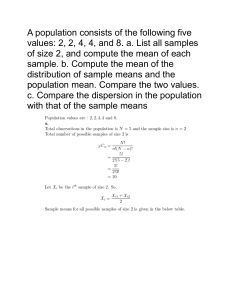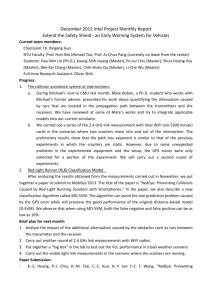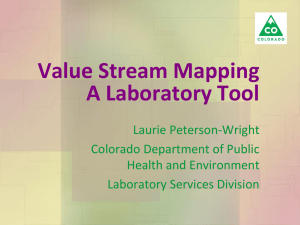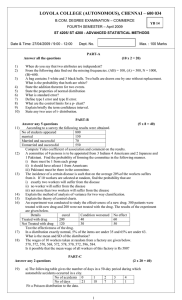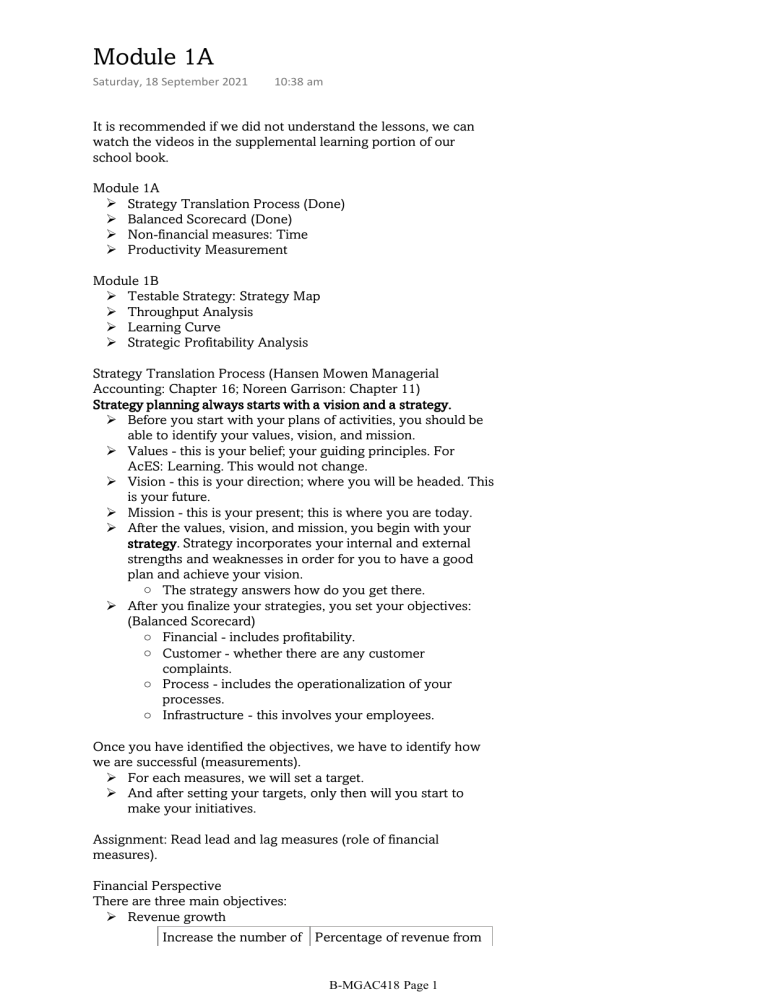
Module 1A Saturday, 18 September 2021 10:38 am It is recommended if we did not understand the lessons, we can watch the videos in the supplemental learning portion of our school book. Module 1A ➢ Strategy Translation Process (Done) ➢ Balanced Scorecard (Done) ➢ Non-financial measures: Time ➢ Productivity Measurement Module 1B ➢ Testable Strategy: Strategy Map ➢ Throughput Analysis ➢ Learning Curve ➢ Strategic Profitability Analysis Strategy Translation Process (Hansen Mowen Managerial Accounting: Chapter 16; Noreen Garrison: Chapter 11) Strategy planning always starts with a vision and a strategy. ➢ Before you start with your plans of activities, you should be able to identify your values, vision, and mission. ➢ Values - this is your belief; your guiding principles. For AcES: Learning. This would not change. ➢ Vision - this is your direction; where you will be headed. This is your future. ➢ Mission - this is your present; this is where you are today. ➢ After the values, vision, and mission, you begin with your strategy. Strategy incorporates your internal and external strengths and weaknesses in order for you to have a good plan and achieve your vision. ○ The strategy answers how do you get there. ➢ After you finalize your strategies, you set your objectives: (Balanced Scorecard) ○ Financial - includes profitability. ○ Customer - whether there are any customer complaints. ○ Process - includes the operationalization of your processes. ○ Infrastructure - this involves your employees. Once you have identified the objectives, we have to identify how we are successful (measurements). ➢ For each measures, we will set a target. ➢ And after setting your targets, only then will you start to make your initiatives. Assignment: Read lead and lag measures (role of financial measures). Financial Perspective There are three main objectives: ➢ Revenue growth Increase the number of Percentage of revenue from new products new products. B-MGAC418 Page 1 new products ○ new products. Create new application. Percentage of revenue from new applications. Develop new Percentage of revenue from customers and markets new sources Adopt a new pricing strategy Product and customer profitability ➢ Cost reduction ○ Reduce unit product cost Unit product cost Reduce unit customer cost Unit customer cost Reduce distribution channel cost Cost per distribution channel ➢ Asset utilization ○ Improve asset utilization Return on investment/Economic value added. Customer Perspective ➢ Performance Value Objectives ○ Post-purchase cost are those incurred by the customers after they purchased a product. The purchase cost of a car is the list cost of the car. But the post-purchase costs included in a car are the fuel and repairs and maintenance. Clients would want fuel efficient cars for long-term customer maintenance. Decrease Price Price Decrease post-purchase Post-purchase costs cost ○ Improve product functionality Ratings from customer surveys Improve product quality Percentage of returns. Increase delivery reliability On-time delivery percentage/Aging schedule Improve product image and reputation Ratings from customer surveys. ➢ Core objectives - this talks about the customer. ○ How do you know that your market share is existing in an organization? If they are not mutually exclusive, then you can check by how much the customers are devoting for a specific product/organization. For mutually exclusive products, if they can only buy one specific product, what product would they buy? ○ How do you know that your income comes from repeat customers? For a product with a lock-in period/subscription period, and the customers have the option to renew, this is a good business model to retain your customers. You have to check where your revenue comes from. ○ How do you know customer satisfaction? In organizations, we conduct surveys. For teachers, the students give evaluations. Their scorecards are based on our evaluation (their profitability comes from our evaluations) Increase Market share (percentage of market). B-MGAC418 Page 2 Increase market share Market share (percentage of market). Increase customer retention Percentage growth of business from existing customers / percentage of repeat customers. ○ Increase customer acquisition Increase customer satisfaction Number of new customers. Ratings from customer surveys. Operations/Process Objectives ➢ Innovation ○ Increase in the number of new products Number of new products vs. planned Increase proprietary products Percentage revenue from proprietary products Decrease new product development time Time to market (from start to finish) ➢ Operations Increase process quality Quality cost/output yields/percentage of defective units. ○ Increase process efficiency/productivity Unit cost trends and output/input Decrease process time Cycle time and velocity ➢ Product services (?) Infrastructures/Employee ➢ The employees need to be happy for them to be productive and gain revenue for the organization. ➢ Turn-over is the rate by which an employee stays in a certain position. ➢ How do you know that your employees are motivated? When your employees are suggesting ideas. You would know that they are engaged and that they are really motivated, as long as their ideas are open and those ideas are implemented. Increase employee Employee satisfaction ratings. capabilities Employee turnover percentages. Employee productivity (revenue/employee) Hours of training. Strategic job coverage ratio (percentage of critical job requirements filled). ➢ Increase motivation and alignment. Suggestions per employee. Suggestions implemented per employee. Increase information systems capabilities Percentage of processes with real time feedback capabilities. Percentage of customer-facing employees with online access of B-MGAC418 Page 3 capabilities employees with online access of customer and product information. Time ➢ In the process objectives, there are three measures in our operations: quality, efficiency/productivity, and time. ➢ Time is more on cycle time and velocity, as well as the MCE. Time Performance Measures: Velocity How much are you able to make over time. Hence: V = Units/Time Cycle Time How fast are you able to make a certain unit. Hence: CT = Time/Unit Manufacturing Cycle Efficiency (MCE) Has four metrics: Process time (value added) Move time (non-value added; how fast you move products from one plant to other plants) Inspection time (non-value added; checks how you comply with the standards) Wait time/Queue time (non-value added; how long before you can start an operation. ➢ Value-added time/Throughput-time or Process / (Process + Move + Inspection + Wait) or P / (P+M+I+W) Wait Time (Average Demand * Manufacturing Time^2) / (2 * Unused Capacity) Total Production (Average Demand * Manufacturing Time Time^2) Unused Capacity Actual machine capacity - (Actual average number of orders for gears * Manufacturing time per order for gears) Conversion Cost Conversion cost per ➢ unit Conversion cost per unit * Cycle Time Problem 16-13 A manufacturing cell has the theoretical capacity to produce 360,000 stereo speakers per quarter. The conversion cost per quarter is $720,000. There are 60,000 production hours used within the cell per quarter. Required: 1. Compute the theoretical velocity (per hour) and the theoretical B-MGAC418 Page 4 1. Compute the theoretical velocity (per hour) and the theoretical cycle time (minutes per unit produced). Solutions: Velocity: 360,000 units / 60,000 hours = 6 units/hour Cycle Time: 1/360,000 * (60 * 60,000) = 10 minutes/units Alternative Solutions (if ever that the theoretical velocity is given) If the 6 units/hour is given, then for one hour, we have six units. Cycle time: 1/6 (reciprocal) * (60/1) = 10 minutes/units 2. Compute the ideal amount of conversion cost per minute that will be assigned per speaker. Solution: Conversion Cost per minute: 720,000 per quarter/ (60,000 hours * 60 minutes/hour) = $0.2 cost per minute. Conversion Cost per unit: 0.2 * 10 = $2 per unit 3. Compute the amount of actual conversion cost per unit per minute and manufacturing cycle efficiency. Throughput time * Conversion cost = Actual Conversion Cost. Actual Conversion Cost = 50 * 0.2 = $10 per unit Manufacturing Time Process Time = 10 minutes (the cycle time) Move Time = 12 minutes Wait time = 10 minutes Inspection = 18 minutes Throughput Time = 10 + 12 + 10 + 18 = 50 minutes MCE = 10 / 50 = 0.2 or 20% 4. How much is the non-value added time and cost? How much is it costing per speaker? Non-Value added time = Move + Wait + Inspection Non-Value added time = 12 + 10 + 18 = 40 minutes Cost of non-value added time: 40 * $0.2 = $8 per minute Alternative Solution: $10 - $2 A theoretical cycle time is the process time. However, if there is an actual cycle time, this includes the other non-value added cycle time. Hence, the actual cycle time in this problem is 50 minutes. NOT ALL CYCLE TIME ARE PROCESS TIME. Noreen's Methodology B-MGAC418 Page 5 The wait time here is different from the queue time. The wait time is the time before the production starts. This wait time is not included in the computation of the MCE. But the wait time here is considered in the delivery cycle time. Novex Company keeps careful track of the time to complete customer orders. During the most recent quarter, the following average times were recorded for each unit of order. Wait Time = 17 Days Inspection Time = 0.4 Days Process Time = 2.0 Days Move Time = 0.6 Days Queue Time = 5 Days Goods are shipped as soon as the production is completed. 1. Compute for the throughput time. Throughput time = .4 + 2 + .6 + 5 = 8 Days 2. Compute the manufacturing cycle efficiency (MCE). The value added percentage is also the MCE. MCE = 2 / 8 = 0.25 or 25% 3. What percentage of the production time is spent on non-value added activities? NVAT = (.4 + .6 + 5) / 8 = 0.75 or 75% 4. Compute the delivery cycle time: Delivery Cycle Time = Wait Time + Throughput Time Delivery Cycle Time = 8 + 17 = 25 Days Horngren's Methodology: Receipt Time = the time where the order was received from the customer. Delivery Time = the time by which the order is delivered to the customer. The higher the manufacturing time, the higher likelihood that they would wait for the production to start. B-MGAC418 Page 6 would wait for the production to start. The denominator is the unused capacity. Problems Little Dog Unlimited makes small motorcycles. The monthly demand ranges from 80 to 100 motorcycles. The average demand is 92 motorcycles. The plant operates 300 hours a month. Each cycle takes approximately 1.5 hours. What is the average waiting time and delivery cycle time for cycles. Solution: Total Manufacturing Hours = 92 * 1.5^2 = 207 Unused Capacity = 2 * (300 - (92 *1.5)) = 324 Waiting Time = 207 / 324 = 0.6389 hour Delivery Cycle Time Waiting Time + Throughput Time = 0.639 + 1.5 = 2.139 hours If the company adds a new line of scooters, initial demand will be 20 per month. Each scooter will take 1 hour to make. What are the average waiting times and delivery cycle times if both cycles and scooters are produced? Solution: Total Manufacturing Hours = (92 * 1.5^2) + (20 * 1^2) = 227 Unused Capacity = 2 * (300 - (92 * 1.5 ) - (20 * 1)) = 284 Waiting Time = 227 / 284 = 0.7993 hour Delivery Cycle Time Delivery Cycle Time (Motorcycle) ○ 0.799 + 1.5 = 2.299 hours Delivery Cycle Time (Scooter) ○ 0.799 + 1 = 1.799 hours To offset approaching production capacity, expanding the assembly line is possible. This will decrease manufacturing time for all products by 20%. What are the average waiting times and delivery cycle times if both cycles and scooters are produced and the assembly line is enlarged? Solution: Total Manufacturing Hours = (92 * (1.5*.8)^2) + (20 * (1*.8)^ 2) = 145.28 Unused Capacity = 2 * (300 - (92 * 1.2) - (20 * .8)) = 347.2 Waiting Time = 145.28 / 347.2 = 0.4184 Delivery Cycle Time Delivery Cycle Time (Motorcycle) ○ 0.418 + 1.2 = 1.618 hours Delivery Cycle Time (Scooter) ○ 0.418 + .8 = 1.218 hours Expanding the assembly line will increase the cost of cycles from 400 to 500 and scooters from 200 to 240. The change will also cause increases in prices from 700 to 750 for cycles and from 450 and 500 for scooters. Assume average sales and that sales equal production. What is the expected monthly margin without scooters if the company sells all 92 cycles it manufactures without changing the assembly line?120 What are the expected monthly contribution margins if scooters are made with the current assembly line with the new assembly line? What action do you B-MGAC418 Page 7 assembly line with the new assembly line? What action do you recommend? Without changing assembly line Cycles Scooters Total Sales 92 * 700 64,400 ➢ 20 * 450 Manufacturing Cost 92 * 400 9,000 36,800 20 * 200 Expected Margin 4,000 27,600 5,000 With new assembly line Cycles 32,600 Scooters Total Sales 92 * 750 ➢ 69,000 20 * 500 10,000 Manufacturing Cost 92 * 500 20 * 240 Expected Margin 46,000 4,800 23,000 5,200 28,200 Productivity is measured as (Output / Input) Hansen and Mowen How do you know that your productivity increased? If you can produce the same output with fewer inputs, or if you can produce more outputs with the same inputs, or if you can increase your outputs with LESS inputs. Illustration: B-MGAC418 Page 8 Productivity Measures Partial Productivity Ratio Output / Input Total Factor Productivity Output / Total Inputs (should be computed with a common denominator, such as price) ProductivityNeutral Quantity (PQ) Current year Output/Prior Year Partial Recovery Ratio Growth Component (PQ - Prior Year Quantity) * Prior Year Price Price Recovery Component (Current Year Price - Prior Year Price) * PQ Productivity Component (Current Year Quantity - PQ) * Current Year Price Hansen and Mowen Problem: Compute the partial productivity ratio. Inputs: Power and Materials. Power: For 2007: 96,000 / 12,000 = 8 For 2008 120,000 / 12,000 = 10 Materials For 2007: 96,000 / 24,000 = 4 For 2008: 120,000 / 35,000 = 3.4286 The higher your productivity ratio, the better. In 2007, for each unit of power, you can produce 8 products. In 2008, for each input of material, you are able to produce 4 outputs. But for 2008, for each input of materials, you can only produce 3.4286. B-MGAC418 Page 9 each input of materials, you can only produce 3.4286. In totality, did your productivity improve? As the productivity of power increased, while the productivity of materials decreased. To check the total factor productivity, you would always want to use the CURRENT price of inputs. CURRENT PRICE OF INPUTS. Hence, to prevent price variances, we are going to use the quantity of past inputs multiplied by the CURRENT PRICES. For 2007: Output = 96,000 Input = (12,000 * 2) + (24,000 * 5) = 144,000 TFP Ratio = 96,000 / 144,000 = 0.6667 For 2008: Output = 120,000 Input = (12,000 * 2) + (35,000 * 5) = 199,000 TFP Ratio = 120,000 / 199,000 = 0.603 We do not need to use the unit selling price for the outputs, since we are checking the productivity of our inputs. In essence, we are not checking for the price variances, we are checking the productivity variances. B-MGAC418 Page 10
